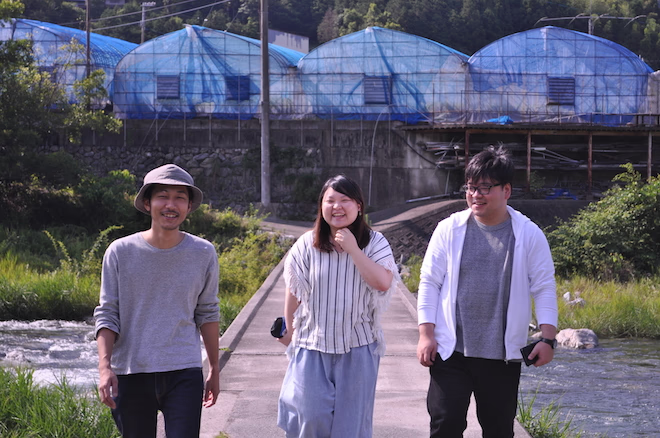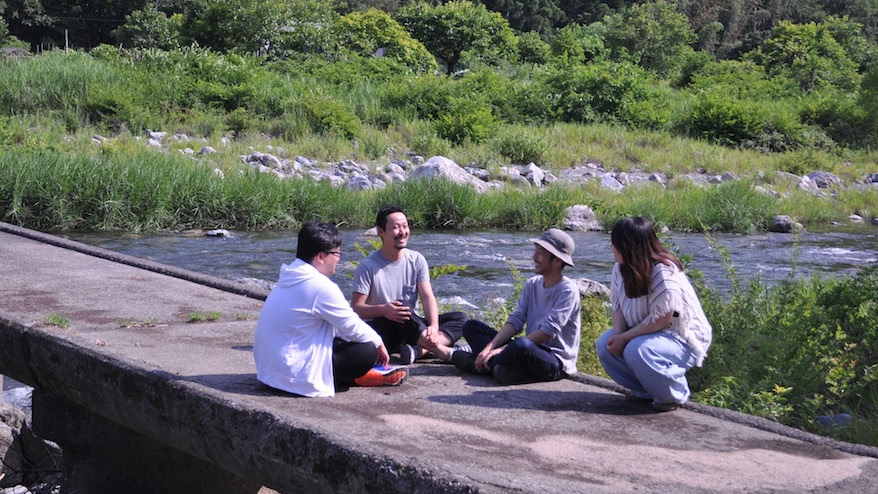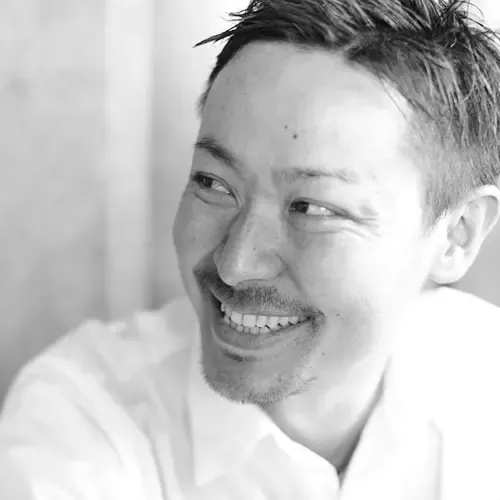こんにちは、WS(Webマスターサポート)部の栗原です。
現在、私の所属するWS部の拠点は、代々木、神山の2つがあり13名のメンバーが在籍しています。
以前の記事で、神山サテライトオフィス新設から約半年のタイミングで、代々木〜神山で業務をどうやってすすめていく?といった記事がありました。その続編ではないですが、2年目を迎えた今、改めて、代々木〜神山間のコミュニケーション手法や連携の状況など、現状の課題も合わせながら紹介してみたいと思います。
今回は、代々木とのやり取りが多い神山メンバーに協力してもらい、具体的な話を聞いてみました。
代々木〜神山間の連携、その後どんな感じ?
2拠点において連携が必要な部分として、マネジメント業務、リソース調整、案件相談などがありますが、その中で最も多いのが、案件を進める上でのメンバー間のやりとりです。
私達の主業務である運用案件は、その性質上クライアントと長い付き合いとなるため、クライアントごとに専任の運用体制を構築しています。メンバー構成は、代々木メンバーのみの場合もあるし、代々木&神山メンバーで構築することもあります。
例えば、ディレクター(代々木)デザイナー(神山)コーダー(神山)など拠点をまたぐ場合は、メンバー間のやり取りが頻繁に発生することになります。このような場合に、どんな風に代々木〜神山間のやり取りを行っているのか聞いてみました。
Q1:どんなツールでやりとりを行っている?
香川:基本、ChatWorkでのやり取りが多いです。あと、急ぎの要件などは電話で連絡をしたり、社内ミーティングはGoogleハングアウトで行ってます。自分たちが使っているPCがデスクトップなので、自分の席でデスクトップPCから接続してますね。ノートPCを持ってるのが栗原さんだけなので、借りられるときはノートPCで別の部屋で繋いだり。あと、打合せの内容によっては、スマホでハングアウトに繋いで会話してます。
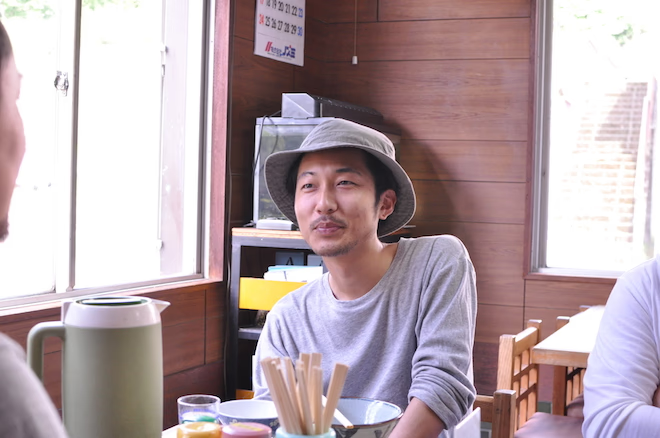
デザイナー/ディレクターの香川(神山勤務歴:オフィス開設当初から約1年半)
Q2:Googleハングアウトで「やりづらい部分」は?
大坂:毎日夕方に、代々木と神山で案件の進捗状況を確認してるんですが、さっきも話に出たように自分のPCがデスクトップなので席から移動ができません。なので、他のメンバーの声や電話の音とか色んな音を拾って(ハウリング)しまうんですよね。
ハングアウト用のノートPCがあれば、打合せスペースに移動して、神山〜代々木で1台ずつ繋げるので効率的かなと。あとは、代々木みたいにクロームボックス(Google のクラウド型テレビ会議システム)があれば便利ですね。
香川:あと、回線が安定しないのもちょっと困ってるかも(笑)。代々木と繋いでるときに、声がとぎれとぎれになることがあって。1対1ならその場で聞けるんですが、打合せって流れみたいなものがあるじゃないですか。自分が聞くことで流れを止めてしまいそうな時は、タイミングを見計らって確認をするようにしていますね。
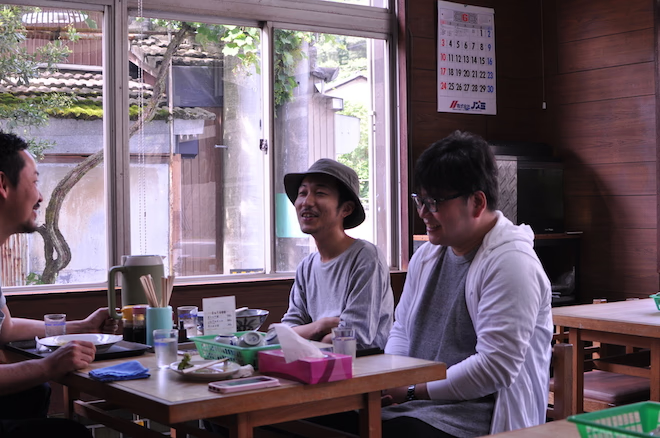
写真右:コーダー/ディレクターの大坂(神山勤務歴:約半年 ※モノサス塾卒塾後に2年間代々木に勤務して今年1月に徳島にUターン)
代々木との打合せはGoogleハングアウトで行うことが日常になってきていますが、接続するPCや回線などのハード面の改善は今後の検討課題です。また、画面越しの打合せになるため、いつも以上に相手への気遣いが必要だと感じています。
相手にちゃんと伝わっているのか顔をみて確認したり、ちゃんと聞こえているよと、返事を声に出してちゃんとするとか、マイクに向かって話しかけるとか、テレビ会議を行う上での上手なやり取り(リテラシー)も、実は大事な要素です。
接点を増やしたい、そのための試行錯誤…
同じ部内と言えでも、顔を合わせたことのないメンバーもいたり、声を聞いたことがあるが顔を見たことないなど、同じ案件に携わることがなければ接点を持つ機会が少ないのが現状です。
離れた場所で働いているので、しょうがないのかもしれませんが、せっかく同じ部内で働いているのに、ただただ、仕事の話を電話でするだけで終わるのはとてもさみしく、相手のことを知るきっかけもなく、相手を気遣うことももちろんできません。
抜本的な解決策ではないですが、コミュニケーションツールの1つとして、常時接続できるハングアウトを代々木神山に1台ずつ設置して、社内の雰囲気を見れるようにしました。
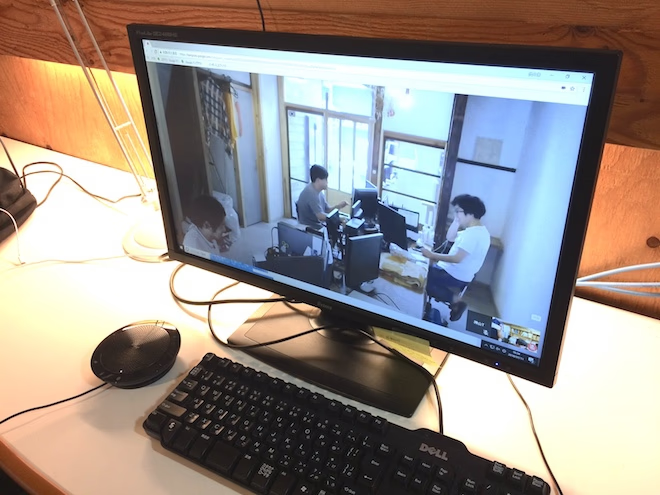
常時接続の様子(代々木から見た神山オフィス)このようにモニターに常に表示されます。
Q3:常時接続(Googleハングアウト)始めてみてどう?
澤田:よく名前を聞いていた代々木のメンバーの方が、忙しくて体調を崩していないか心配だったんですが、画面越しに顔をみると意外と元気な姿だったので安心しました(笑)。
大坂:全体的にうまく活用しきれていないかも。代々木側のカメラの位置が変わってオフィスの様子が見えなかったり、こちらから話しかけてもスピーカー音量が小さいせいか誰も反応してくれなかったり…ちょっと寂しい(笑)。
澤田:確かに部屋の状況は見えるといいですね。代々木のメンバーと電話したいと思ったときに、在席しているか確認して掛けることができるので。逆も同じで、代々木から神山に掛ける場合も、席にいるかどうか確認してもらえると取り次ぐ頻度も少なくて済みますしね。
大坂:良い部分としては、コミュニケーションのきっかけが増えたこと。自分は半年前まで代々木勤務でしたが、当時あまり話す機会がなかったメンバーと、常時ハングアウトを介して手を振ったりするようになって、その点ではコミュニケーションが増えましたね。
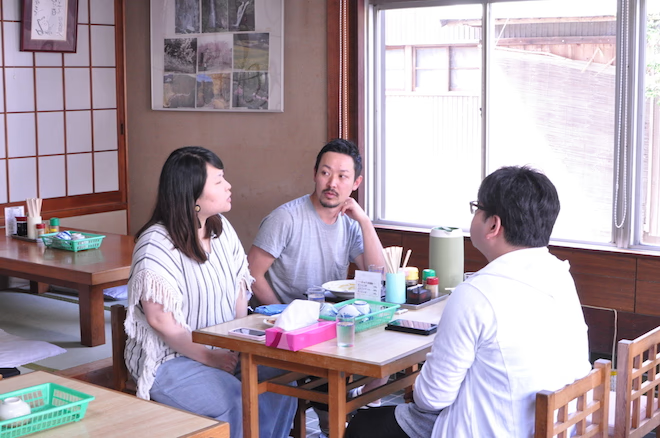
写真左:ディレクターの澤田(神山滞在期間:モノサス塾を卒塾してから約2年)
試しに導入してみた代々木〜神山の常時接続ですが、全力で手を降ってくれるメンバーがいたり、いつも見えてるからこそコミュニケーションを取るようになったという意見もあり、意外な効果も出ているようです。
スタートしてまだ日が浅いことやカメラの視野角の問題など、これから改善する点もいろいろとありますが、相手の状況を知ることのできるコミュニケーションツールが増えたこと自体は良いことですし、その使い方の可能性が広がるきっかけとなればいいと思ってます。
なぜ常時接続をやっているのか。その目的を、代々木、神山、双方のメンバーが理解して、積極的に活用してもらえればと思います。
もっと「心の距離」を詰めていきたい
現実として、代々木と神山が物理的に離れていることはどうにも出来ませんが、同じ部署で同じ業務に携わるメンバーとして、その距離をいかに近づけられるのか。みんなで考えながら取り組んでいく必要があります。
今回常時ハングアウトを設置してみて、今まで接点がなかった部分から、少しでもコミュニケーションのきっかけができたということは、良い方向へ進んでいるのかなと思います。
また、私は業務上、毎月代々木に来て、画面越しではない直接のコミュニケーションを取ることができる状況にありますが、やはり顔を見て直接会話することの良さもあると感じています。まずは、画面越しのコミュニケーションを大事にしつつ、次のステップとして代々木と神山お互いが行き来しながら、直接会話して一緒に仕事ができる。
そんなリアルな接点を増やしていく方法も、今後は考えていきたいと思ってます。
